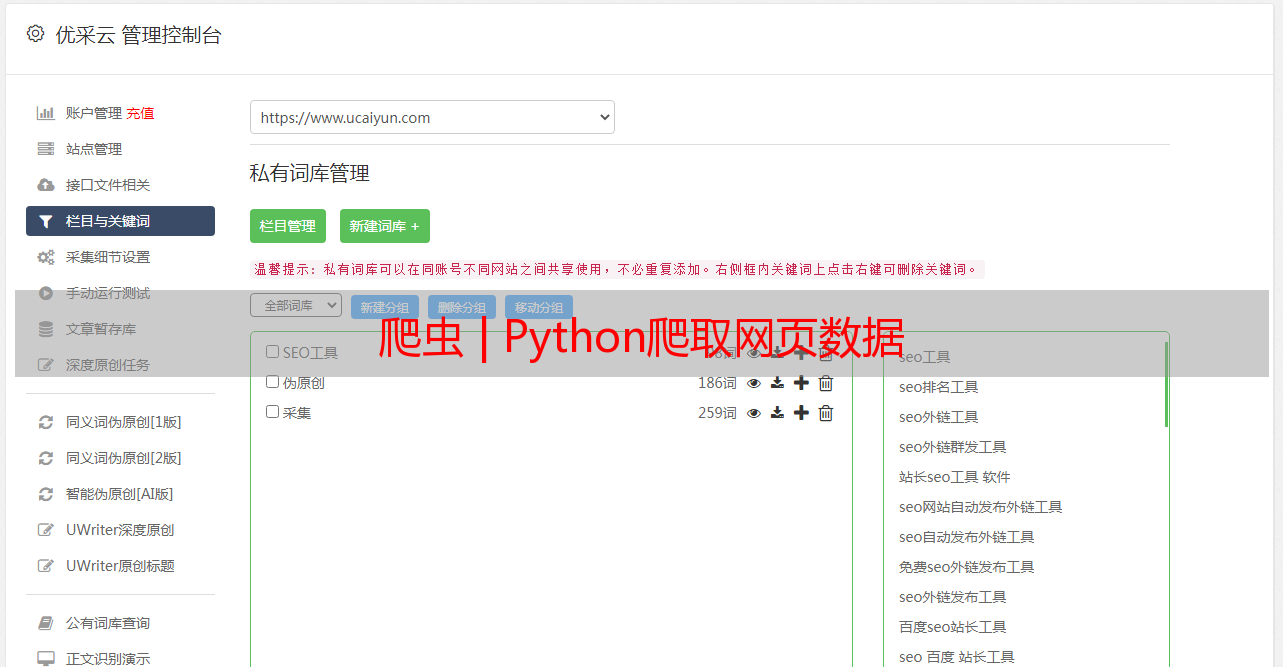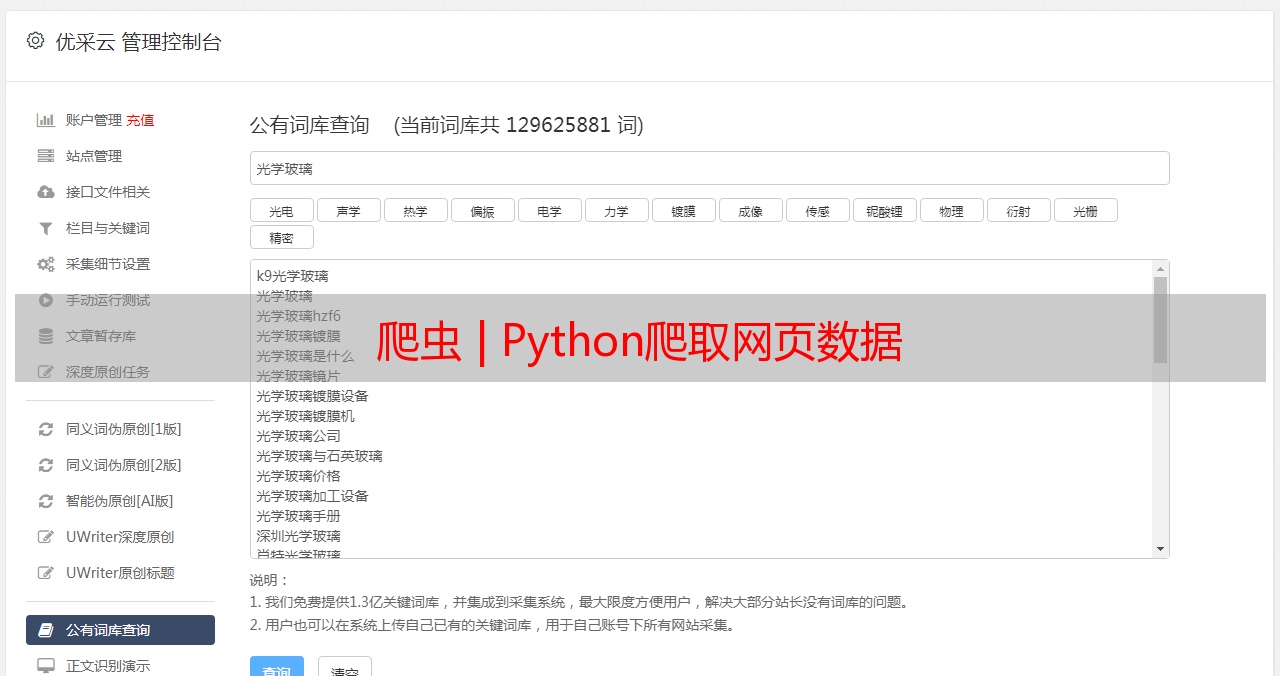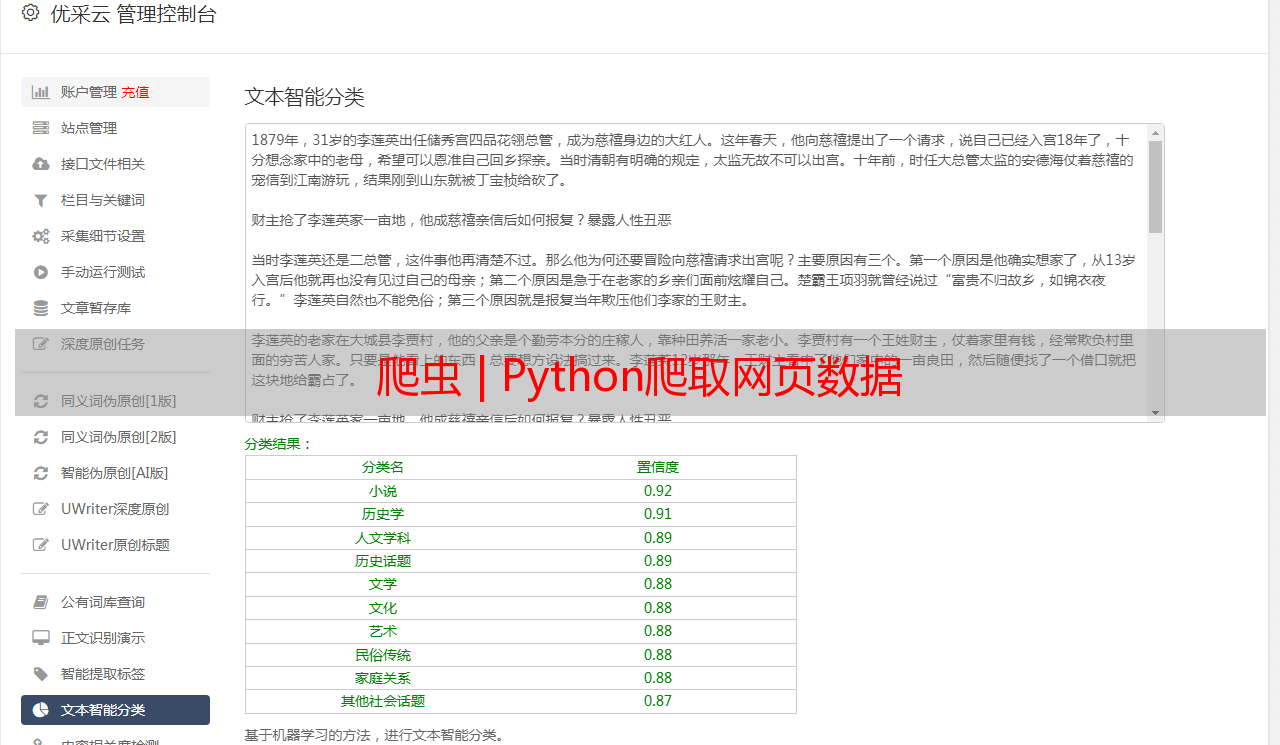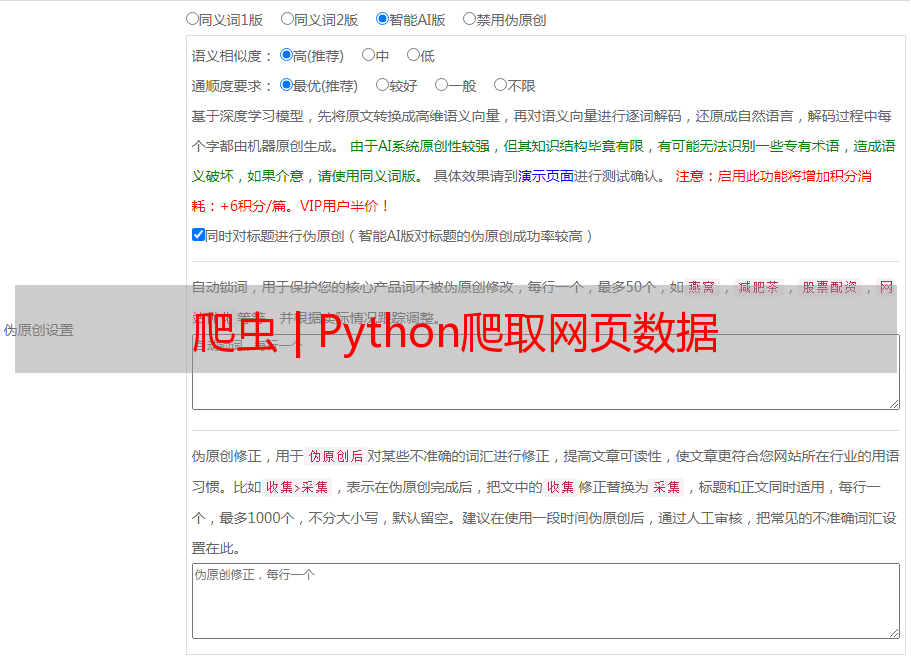爬虫 | Python爬取网页数据
优采云 发布时间: 2022-05-25 09:21爬虫 | Python爬取网页数据
之前也更过爬虫方面的内容 ,今天再更一次。后面会陆续更一些爬虫方面的内容(HTML, requests, bs4, re ...),中间可能会插播一些 numpy 和 pandas 方面的内容。在时间允许的情况下会更一些WRF模式方面的内容。也算是立了个更新内容的 flag,但是更新时间就不立了==
----------- 华丽的分割线 ------------
当你没有数据的时候怎么办呢?有些时候能直接得到 csv 格式数据,或是通过API获取数据。然而,有些时候只能从网页获取数据。这种情况下,只能通过网络爬虫的方式获取数据,并转为满足分析要求的格式。
本文利用Python3和BeautifulSoup爬取网页中的天气预测数据,然后使用 pandas 分析。
Web网页组成
我们查看网页时,浏览器会向web服务器发送请求,而且通常使用 GET 方法发送请求,然后服务器返回响应,通过浏览器的解析就能看到所请求的页面了。web服务器返回的文件主要是以下几种类型:
浏览器接收到所有文件之后,会对网页进行渲染,然后向我们展示。虽然显示网页的幕后发生了很多过程,但是在爬取数据时我们并不需要了解这些过程。在爬取网页数据时,主要关注的就是网页的主要内容,因此,主要关注HTML。
HTML
HTML(超文本标记语言)是创建网页时所需要的语言,但并不是像Python一样的编程语言。相反,它是告诉浏览器如何排版网页内容的标记语言。HTML类似文本编辑器,可以对字体进行处理(加粗,放大缩小),创建段落等。
为了更有效率的爬取网页数据,我们需要先快速的了解一下HTML。HTML由一系列标签(tags)构成。最基本的标签是 。标签的作用就是告诉浏览器网页中有什么。我们可以使用下面的标签创建最基本的HTML文档(注:打开文本编辑器,复制以下内容,然后存储为以 html 为后缀的任意名称文件,比如 document.html)。
<br />
然后用浏览器打开存储的文件。因为只包含一对标签,标签中没有添加任何内容,所以用浏览器打开后不会看到任何内容。
下面,除了 标签之外,添加了 和 标签。 标签包含网页的主要内容, 标签包含的是网页的标题。在进行网页爬取时,这三个标签是非常有用的。
<br /> <br /> <br /> <br /> <br />
除了多了两个标签之外,并没有添加其它内容,因此用浏览器打开之后仍是空文档。
现在,我们向网页中添加一些内容,用
标签来标识。
标签所对应的内容表示在网页中是一个段落。
<br /> <br /> <br /> <br /> <br /> Here's a paragraph of text!<br /> <br /> <br /> Here's a second paragraph of text!<br /> <br /> <br />
用浏览器打开之后是以下内容(上面的颜色是为了标识,真正显示时是黑色字体):
Here's a paragraph of text!<br /><br />Here's a second paragraph of text!
通常所使用的标签名称依赖于其相对于其它标签的位置。
还可以添加一些属性到html文档中来改变其行为:
<br /> <br /> <br /> <br /> <br /> Here's a paragraph of text!<br /> Learn Data Science Online<br /> <br /> <br /> Here's a second paragraph of text!<br /> Python<br /> <br /> <br />
页面内容如下所示:
Here's a paragraph of text! Learn Data Science Online<br /><br />Here's a second paragraph of text! Python
在上面的示例中,添加了两个 标签。 标签表示链接,告诉浏览器此链接会转到另一个网页。href 属性表示链接的地址。紧随其后的字符串表示别名。
和
均是非常常见的 html 标签,还有一些其它标签,比如:
完整标签列表在这里[注1]。
在正式开始爬取网页前,先了解一下 class 和 id 属性。这些特殊属性确定了 HTML 元素名称,当我们爬取时更容易进行交互。一个元素可以有多个类,一个类可以和元素之间共享。每个元素只能有一个 id,而一个 id 只能在一个网页中使用一次。class 和 id 是可选的,不是每一个元素都有 class 和 id。
强行解释:你(元素)有很多朋友(类),朋友(类)之间可能有你(元素)这个交集(共享),而你(元素)只有一个*敏*感*词*(id),比如你在认证领奖时*敏*感*词*只能用一次,不能一个*敏*感*词*领多次。朋友和*敏*感*词*是可选的,因为你可能没有朋友(孤独行者),也没有*敏*感*词*(小黑孩)。
添加 class 和 id 到示例中:
<br /> <br /> <br /> <br /> <br /> Here's a paragraph of text!<br /> Learn Data Science Online<br /> <br /> <br /> Here's a second paragraph of text!<br /> Python<br /> <br /> <br />
看起来和上面的示例是一样的结果(添加了 class 和 id 并不会影响网页内容和布局):
Here's a paragraph of text! Learn Data Science Online<br /><br />Here's a second paragraph of text! Python
requests 库
爬取网页数据的第一步就是下载网页。我们可以利用requests 库向web服务器发送 GET 请求下载网页内容。使用requests时有几种不同的请求,GET 请求是其中一种,了解更多请看 。
现在,我们试着下载一个简单的网页。首先,需要使用 requests.get 方法下载页面:
import requests<br /><br />page = requests.get("http://dataquestio.github.io/web-scraping-pages/simple.html")
运行了get 请求之后,会获得响应对象,其中包含了状态码属性,表示是否下载成功。
page.status_code<br /><br />200
状态码为 200 表示网页下载成功。我们不需要完整的了解状态码,通常情况下状态码以2开始即表示成功。状态码以4或5开始表示出错。
使用 content 属性可以打印页面内容:
page.content<br /><br />b'\n\n \n A simple example page\n \n \n <p>Here is some simple content for this page.\n \n'</p>
BeautifulSoup 解析网页
下载好页面之后,使用 BeautifulSoup 解析页面内容,然后从 p 标签提取文本。导入库然后创建实例来解析网页:
from bs4 import BeautifulSoup<br />soup = BeautifulSoup(page.content, 'html.parser')
使用 prettify 属性可以将页面内容打印出来:
print(soup.prettify())<br /><br /><br /><br /> <br /> <br /> A simple example page<br /> <br /> <br /> <br /> <p><br /> Here is some simple content for this page.<br /> <br /> <br /></p>
因为所有标签都是嵌套的,我们可以一次移动一层。使用 soup 的 children 属性可以选择页面的所有顶层元素。
注意:children 返回的是*敏*感*词*,需要调用 list 函数转换为列表。
list(soup.children)<br /><br />['html', '\n', <br /> <br /> A simple example page<br /> <br /> <br /> <p>Here is some simple content for this page.<br /> <br /> ]</p>
上述结果表明,页面顶层有两个标签: 和 标签。换行符 (\n) 也在列表中。下面看一下列表中每个元素的类型:
>> [type(item) for item in list(soup.children)] <br /><br />[bs4.element.Doctype, bs4.element.NavigableString, bs4.element.Tag]
每一项都是 BeautifulSoup 对象。 Dcotype 对象包含文档类型信息,NavigableString 呈现的是包含文档中的文本,Tag对象包含其它嵌套标签。最重要且经常用到的对象是 Tag 对象。
Tag 对象在HTML文档中起到导航作用,可以用来获取标签和文本。更多BeautifulSoup 对象看这里 [注2]。
通过 soup.children 获取 html 标签信息:
html = list(soup.children)[2]
children 属性返回的每一项都是 BeautifulSoup 对象,因此可以直接调用 children 方法。获取 html 标签的子标签信息:
list(html.children)<br /><br />['\n', <br /> A simple example page<br /> , '\n', <br /> <p>Here is some simple content for this page.<br /> , '\n']</p>
如上所示,有两个顶层标签: 和 。如果想要获取 title 和 p 标签对应的信息,需要先获取其所对应的父标签信息。比如,获取 p 标签信息,要先获取 标签信息:
body = list(html.children)[3]
因为 标签中只有 p 标签,所以可以很方便的获取 p 标签信息:
list(body.children)<br /><br />['\n', <p>Here is some simple content for this page., '\n']</p>
获取 p 标签信息:
p = list(body.children)[1]
获取 p 标签之后,使用 get_text 方法可以提取标签中的信息:
p.get_text()<br /><br />'Here is some simple content for this page.'
获取所有标签信息
上面所演示的内容对于了解页面导航信息非常有用,但是使用了很多命令来完成意见非常简单的任务。如果你想提取单个标签,可以使用 find_all 方法,可以获取页面中的所有标签实例:
soup = BeautifulSoup(page.content, 'html.parser')<br />soup.find_all('p')<br /><br />[<p>Here is some simple content for this page.]</p>
注意: find_all 返回的是列表,为了获取指定标签信息,需要循环或指定索引。
获取标签之后同样用 get_text 方法获取文本信息:
soup.find_all('p')[0].get_text()<br /><br />'Here is some simple content for this page.'
如果不想获取标签所有实例,可以使用 find 方法获取标签的第一个实例:
soup.find('p')<br /><br /><p>Here is some simple content for this page.</p>
利用 class 和 id 搜索标签
前面介绍了 class 和 id,但是还没有介绍它们的有用之处。class 和 id 是 CSS 所使用的,主要用来确定 HTML 元素应该使用什么类型。可以使用它们爬取特定元素。比如爬取下列网页时(URL:):
<br /> <br /> A simple example page<br /> <br /> <br /> <br /> <p span class="hljs-class" style="color: rgb(51, 51, 51); font-weight: 400; font-style: normal;"span class="hljs-keyword" style="color: rgb(51, 51, 51); font-weight: bold; font-style: normal;"class/span="span class="hljs-title" style="color: rgb(136, 0, 0); font-weight: bold; font-style: normal;"inner/span-span class="hljs-title" style="color: rgb(136, 0, 0); font-weight: bold; font-style: normal;"text/span span class="hljs-title" style="color: rgb(136, 0, 0); font-weight: bold; font-style: normal;"first/span-span class="hljs-title" style="color: rgb(136, 0, 0); font-weight: bold; font-style: normal;"item/span" span class="hljs-title" style="color: rgb(136, 0, 0); font-weight: bold; font-style: normal;"id/span="span class="hljs-title" style="color: rgb(136, 0, 0); font-weight: bold; font-style: normal;"first/span"><br /> First paragraph.<br /> <br /> <br /> Second paragraph.<br /> <br /> <br /> <br /> <br /> First outer paragraph.<br /> <br /> <br /> <br /> <br /> Second outer paragraph.<br /> <br /> <br /> <br />
创建 BeautifulSoup 对象:
page = requests.get("http://dataquestio.github.io/web-scraping-pages/ids_and_classes.html")<br />soup = BeautifulSoup(page.content, 'html.parser')<br />soup<br /><br /><br /><br />A simple example page<br /><br /><br /><br /><p span class="hljs-class" style="color: rgb(51, 51, 51); font-weight: 400; font-style: normal;"span class="hljs-keyword" style="color: rgb(51, 51, 51); font-weight: bold; font-style: normal;"class/span="span class="hljs-title" style="color: rgb(136, 0, 0); font-weight: bold; font-style: normal;"inner/span-span class="hljs-title" style="color: rgb(136, 0, 0); font-weight: bold; font-style: normal;"text/span span class="hljs-title" style="color: rgb(136, 0, 0); font-weight: bold; font-style: normal;"first/span-span class="hljs-title" style="color: rgb(136, 0, 0); font-weight: bold; font-style: normal;"item/span" span class="hljs-title" style="color: rgb(136, 0, 0); font-weight: bold; font-style: normal;"id/span="span class="hljs-title" style="color: rgb(136, 0, 0); font-weight: bold; font-style: normal;"first/span"><br /> First paragraph.<br /> <br /><br /> Second paragraph.<br /> <br /><br /><br /><br /> First outer paragraph.<br /> <br /><br /><br /><br /> Second outer paragraph.<br /> <br /><br /><br />
现在,使用 find_all 方法通过 class 和 id 搜索项。比如,搜索 class 值为 outer-text 的 p 标签:
soup.find_all('p', class_='outer-text')<br /><br />[<p span class="hljs-class" style="color: rgb(51, 51, 51); font-weight: 400; font-style: normal;"span class="hljs-keyword" style="color: rgb(51, 51, 51); font-weight: bold; font-style: normal;"class/span="span class="hljs-title" style="color: rgb(136, 0, 0); font-weight: bold; font-style: normal;"outer/span-span class="hljs-title" style="color: rgb(136, 0, 0); font-weight: bold; font-style: normal;"text/span span class="hljs-title" style="color: rgb(136, 0, 0); font-weight: bold; font-style: normal;"first/span-span class="hljs-title" style="color: rgb(136, 0, 0); font-weight: bold; font-style: normal;"item/span" span class="hljs-title" style="color: rgb(136, 0, 0); font-weight: bold; font-style: normal;"id/span="span class="hljs-title" style="color: rgb(136, 0, 0); font-weight: bold; font-style: normal;"second/span"><br /> <br /> First outer paragraph.<br /> <br /> , <br /> <br /> Second outer paragraph.<br /> <br /> ]
也可以搜索 class 值为 outer-text 的任何标签:
soup.find_all(class_="outer-text")<br /><br />[<p span class="hljs-class" style="color: rgb(51, 51, 51); font-weight: 400; font-style: normal;"span class="hljs-keyword" style="color: rgb(51, 51, 51); font-weight: bold; font-style: normal;"class/span="span class="hljs-title" style="color: rgb(136, 0, 0); font-weight: bold; font-style: normal;"outer/span-span class="hljs-title" style="color: rgb(136, 0, 0); font-weight: bold; font-style: normal;"text/span span class="hljs-title" style="color: rgb(136, 0, 0); font-weight: bold; font-style: normal;"first/span-span class="hljs-title" style="color: rgb(136, 0, 0); font-weight: bold; font-style: normal;"item/span" span class="hljs-title" style="color: rgb(136, 0, 0); font-weight: bold; font-style: normal;"id/span="span class="hljs-title" style="color: rgb(136, 0, 0); font-weight: bold; font-style: normal;"second/span"><br /> <br /> First outer paragraph.<br /> <br /> , <br /> <br /> Second outer paragraph.<br /> <br /> ]
当然也可以通过 id 搜索元素:
soup.find_all(id="first")<br /><br />[<p span class="hljs-class" style="color: rgb(51, 51, 51); font-weight: 400; font-style: normal;"span class="hljs-keyword" style="color: rgb(51, 51, 51); font-weight: bold; font-style: normal;"class/span="span class="hljs-title" style="color: rgb(136, 0, 0); font-weight: bold; font-style: normal;"inner/span-span class="hljs-title" style="color: rgb(136, 0, 0); font-weight: bold; font-style: normal;"text/span span class="hljs-title" style="color: rgb(136, 0, 0); font-weight: bold; font-style: normal;"first/span-span class="hljs-title" style="color: rgb(136, 0, 0); font-weight: bold; font-style: normal;"item/span" span class="hljs-title" style="color: rgb(136, 0, 0); font-weight: bold; font-style: normal;"id/span="span class="hljs-title" style="color: rgb(136, 0, 0); font-weight: bold; font-style: normal;"first/span"><br /> First paragraph.<br /> ]
CSS选择器
CSS选择器(用于确定HTML标签类型)同样可以用来搜索项。比如:
更多选择器在这里 [注3]。
BeautifulSoup 对象支持使用 select 方法通过选择器搜索页面。使用选择器获取 div 标签下的所有 p 标签:
soup.select("div p")<br /><br />[<p span class="hljs-class" style="color: rgb(51, 51, 51); font-weight: 400; font-style: normal;"span class="hljs-keyword" style="color: rgb(51, 51, 51); font-weight: bold; font-style: normal;"class/span="span class="hljs-title" style="color: rgb(136, 0, 0); font-weight: bold; font-style: normal;"inner/span-span class="hljs-title" style="color: rgb(136, 0, 0); font-weight: bold; font-style: normal;"text/span span class="hljs-title" style="color: rgb(136, 0, 0); font-weight: bold; font-style: normal;"first/span-span class="hljs-title" style="color: rgb(136, 0, 0); font-weight: bold; font-style: normal;"item/span" span class="hljs-title" style="color: rgb(136, 0, 0); font-weight: bold; font-style: normal;"id/span="span class="hljs-title" style="color: rgb(136, 0, 0); font-weight: bold; font-style: normal;"first/span"><br /> First paragraph.<br /> , <br /> Second paragraph.<br /> ]
注意: select 方法返回的时 BeautifulSoup 对象列表,就像 find 和 find_all 。
下载天气数据
目前,我们已经知道了提取网页信息的方法。下一步就是确定要爬取的网页。下面以爬取美国国家天气服务的天气信息为例:
网页显示了一周的天气预报信息,包括时间,温度以及一些描述信息。
了解网页结构
第一步,使用 Chrome 开发工具查看网页布局,使用其它浏览器也可以。
按F12即可打开开发者工具,即下图中红色框部分。
Elements 部分包含了网页中的所有标签,通过标签你可以确定页面的布局。
右击页面中 Extended Forecast所对应的网页部分(下图中红色框部分),然后选择 "Inspect"(检查),然后就会定位到 Elements 中的标签(*敏*感*词*阴影部分的父标签)。
然后就能获取到所有的预测数据,在此例中对应的是 id 为 seven-day-forecast 的
标签。
打开
标签的内容就可以发现每一天的预测数据:日期,温度,简要描述。下图中绿色框和红色框分别对应的是一天的预测(包含在 class 为 tombstone-container 的
标签内)。
现在已经知道如何下载网页并解析网页了,下面我们开始实战:
page = requests.get("http://forecast.weather.gov/MapClick.php?lat=37.7772&lon=-122.4168")<br />soup = BeautifulSoup(page.content, 'html.parser')<br />seven_day = soup.find(id="seven-day-forecast")<br />forecast_items = seven_day.find_all(class_="tombstone-container")<br />tonight = forecast_items[0]<br />print(tonight.prettify())<br /><br /><br /> <br /> Tonight<br /> <br /> <br /> <br /> <br /> <br /> <br /> <br />
<br /> Mostly Clear<br /> <br />
<br /> Low: 49 °F<br /> <br /></p>
提取页面信息
单标签信息提取
预测项 tonight 中包含了我们所需要的所有信息,其中包含了四项:
提取预测项名称,简要描述及温度:
period = tonight.find(class_="period-name").get_text()<br />short_desc = tonight.find(class_="short-desc").get_text()<br />temp = tonight.find(class_="temp").get_text()<br /><br />print(period)<br />print(short_desc)<br />print(temp)<br /><br />Tonight<br />Mostly Clear<br />Low: 49 °F
现在,从 img 标签中提取 title 属性。将 BeautifulSoup 对象视作字典,传递需要的属性作为键:
img = tonight.find("img")<br />desc = img['title']<br /><br />print(desc)<br /><br />Tonight: Mostly clear, with a low around 49. West northwest wind 12 to 17 mph decreasing to 6 to 11 mph after midnight. Winds could gust as high as 23 mph.
提取所有信息
上面介绍了如何提起单标签信息,下面介绍如何利用CSS选择器和列表解析,一次提取所有信息:
period_tags = seven_day.select(".tombstone-container .period-name")<br />periods = [pt.get_text() for pt in period_tags]<br />periods<br /><br />['Tonight',<br /> 'Thursday',<br /> 'ThursdayNight',<br /> 'Friday',<br /> 'FridayNight',<br /> 'Saturday',<br /> 'SaturdayNight',<br /> 'Sunday',<br /> 'SundayNight']
按照上面的方式获取了有序的时间名称,现在获取另外3个字段:
short_descs = [sd.get_text() for sd in seven_day.select(".tombstone-container .short-desc")]<br />temps = [t.get_text() for t in seven_day.select(".tombstone-container .temp")]<br />descs = [d["title"] for d in seven_day.select(".tombstone-container img")]<br /><br />print(short_descs)<br />print(temps)<br />print(descs)<br /><br />['Mostly Clear', 'Sunny', 'Mostly Clear', 'Sunny', 'Slight ChanceRain', 'Rain Likely', 'Rain Likely', 'Rain Likely', 'Chance Rain']<br />['Low: 49 °F', 'High: 63 °F', 'Low: 50 °F', 'High: 67 °F', 'Low: 57 °F', 'High: 64 °F', 'Low: 57 °F', 'High: 64 °F', 'Low: 55 °F']<br />['Tonight: Mostly clear, with a low around 49. West northwest wind 12 to 17 mph decreasing to 6 to 11 mph after midnight. Winds could gust as high as 23 mph. ', 'Thursday: Sunny, with a high near 63. North wind 3 to 5 mph. ', 'Thursday Night: Mostly clear, with a low around 50. Light and variable wind becoming east southeast 5 to 8 mph after midnight. ', 'Friday: Sunny, with a high near 67. Southeast wind around 9 mph. ', 'Friday Night: A 20 percent chance of rain after 11pm. Partly cloudy, with a low around 57. South southeast wind 13 to 15 mph, with gusts as high as 20 mph. New precipitation amounts of less than a tenth of an inch possible. ', 'Saturday: Rain likely. Cloudy, with a high near 64. Chance of precipitation is 70%. New precipitation amounts between a quarter and half of an inch possible. ', 'Saturday Night: Rain likely. Cloudy, with a low around 57. Chance of precipitation is 60%.', 'Sunday: Rain likely. Cloudy, with a high near 64.', 'Sunday Night: A chance of rain. Mostly cloudy, with a low around 55.']
存储数据到 DataFrame
下面将数据存储到 pandas 的 DataFrame 中并分析之。DataFrame 可以存储表型数据并很容易的进行数据分析。
将上述信息传递给 DataFrame 类,字典中的键表示列名,键值表示每一列的值:
import pandas as pd<br />weather = pd.DataFrame({<br /> "period": periods, <br /> "short_desc": short_descs, <br /> "temp": temps, <br /> "desc":descs<br /> })<br />weather<br /><br /> desc period short_desc temp<br />0 Tonight: Mostly clear, with a low around 49. W... Tonight Mostly Clear Low: 49 °F<br />1 Thursday: Sunny, with a high near 63. North wi... Thursday Sunny High: 63 °F<br />2 Thursday Night: Mostly clear, with a low aroun... ThursdayNight Mostly Clear Low: 50 °F<br />3 Friday: Sunny, with a high near 67. Southeast ... Friday Sunny High: 67 °F<br />4 Friday Night: A 20 percent chance of rain afte... FridayNight Slight ChanceRain Low: 57 °F<br />5 Saturday: Rain likely. Cloudy, with a high ne... Saturday Rain Likely High: 64 °F<br />6 Saturday Night: Rain likely. Cloudy, with a l... SaturdayNight Rain Likely Low: 57 °F<br />7 Sunday: Rain likely. Cloudy, with a high near... Sunday Rain Likely High: 64 °F<br />8 Sunday Night: A chance of rain. Mostly cloudy... SundayNight Chance Rain Low: 55 °F
现在,我们可以对数据进行简单的分析。比如利用正则表达式和 Series.str.extract 方法获取温度的数值:
temp_nums = weather["temp"].str.extract("(?P\d+)", expand=False)<br />weather["temp_num"] = temp_nums.astype('int')<br />temp_nums<br /><br />0 49<br />1 63<br />2 50<br />3 67<br />4 57<br />5 64<br />6 57<br />7 64<br />8 55<br />Name: temp_num, dtype: object
然后计算温度的平均值:
weather["temp_num"].mean()<br /><br />58.444444444444443
如果某天晚上你要出去,可以查看晚上的天气信息:
is_night = weather["temp"].str.contains("Low")<br />weather["is_night"] = is_night<br />is_night<br /><br />0 True<br />1 False<br />2 True<br />3 False<br />4 True<br />5 False<br />6 True<br />7 False<br />8 True<br />Name: temp, dtype: bool<br /><br />weather[is_night]
下一步
现在你已经了解了如何爬取网页并提取数据。下一步就是选择一个网站然后继续练习。
Just do it!
注1:
注2:#kinds-of-objects
注3:
预览时标签不可点
收录于合集 #
个







